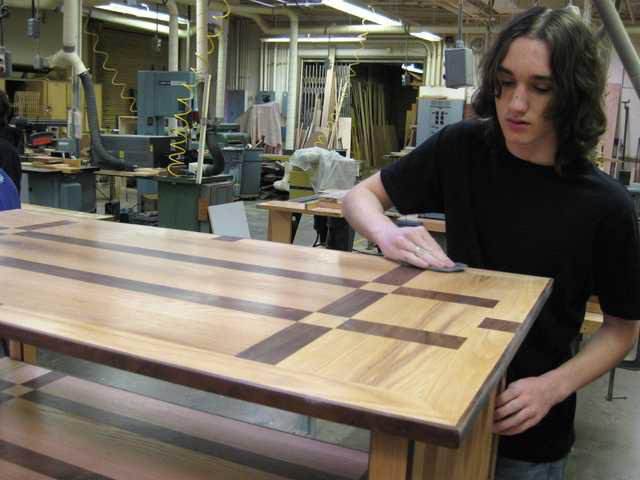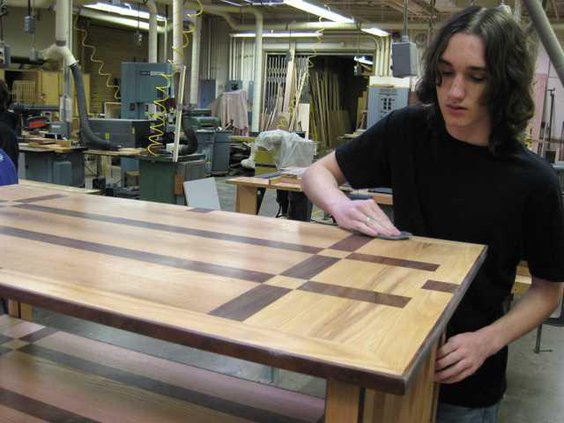In a room where the common sounds are the whirring buzz of saws, the snapping of nail guns, and the clopping of wood boards as they slap together, the distractions seem endless.
However, it’s the possibilities that are endless and the only limit is one’s imagination in the Oakdale High School woodshop.
“You can go as far as you want to go. There’s nothing you can’t build in this shop,” said OHS woodshop teacher Bill McMahon.
He’s taught woodshop classes for about 27 years, with 13 of them at OHS. He’s had thousands of students walk through his doors and some of them have produced not just projects, but works of art in his woodshop classes.
“These guys don’t have any idea what they can do until they try it,” he said.
For example, OHS juniors Jeremy Buranis and Kyle Bochmann have recently finished uniquely different woodshop projects that required a fair amount of time and dedication in research and composition.
Buranis recently put the finishing touches and a final coat of wax on an oak coffee table with black walnut inlays that he started at the beginning of the school year. It took him two to three months just to build the tabletop.
McMahon noted that his student’s coffee table has antique wood in it, as the black walnut is over 100 years old and came from a tree cut down about six years ago on an area ranch. It takes a one-inch thick piece of black walnut a full year to dry if it’s kept indoors, he said, and that it is used for gunstocks and also in high-end veneers such as on auto dashes. Wood for furniture has to be eight percent moisture and is best when it’s air-dried lumber, McMahon said, as opposed to kiln-dried.
Buranis recalled that his project came about when his parents wanted a new coffee table and he came up with the idea to build them one in his woodshop class. Next, he made a few designs on his computer at home. Instead of drawing out plans for his coffee table, he did a step-by-step rendering with a computer program of the measurements and cuts to be made.
The third-year woodshop student is a computer enthusiast, admitting that he spends a lot of time on the computer and if it weren’t for woodshop, he’d be on the computer all the time.
“I love this class,” he said, adding that it’s a good outlet and helps break up his day.
“He laid everything out on the computer first,” an impressed McMahon said, noting that it helped him to see it on the printout and to go over techniques with Buranis to build it.
“I’ve always been into computers and I’ve always done 3-D modeling, programming,” Buranis said. “So it’s a lot easier than drawing it out.”
To start the project, Buranis had to make a jig to cut the inlays on the corners of his coffee table’s legs. McMahon described a jig as a clamping device that duplicates exact cuts every time, to be used on a piece of equipment.
Buranis said that the leg inlays required a lot of patience and were the most difficult aspect of the table. It was a tedious process. One mistake, and he’d have to start all over, he said.
Each leg had to be run through the table saw four different times because of the inlay work and the needed use of the jig. That’s 16 times that he ran the legs through the saw. Each time he did that, he had to screw on and then unscrew the jig, which had 10 screws in it.
Buranis also used mortise and tenon joints to connect table pieces together, which is a type of joint used for thousands of years by woodworkers and is used in quality furniture and is common for mission-style furniture.
He reported that some of the shop equipment he used in making his table were the table saw, brad gun, biscuit jointer, miter saw, and belt sander.
“I’d like to build furniture as a living, that’d be fun,” he said.
Of course, he’d be using his computer to design it first.
Whenever he needed to take a break from working on his coffee table, Buranis would craft executive pens from wood pieces in the shop. He’s given them as gifts and recently had two on hand, one made of maple burl and another made from two different types of exotic woods that were laminated.
“It’s just something I like to do,” he said, and modestly added, “I don’t know who would want to buy one.”
When he was a freshman, Bochmann began making a poker table in woodshop class with a friend, then ended up finishing it on his own during his sophomore year. This year, he began making duck calls in woodshop class.
“I’ve always liked to duck hunt. I realized I could make them instead of buying them,” he said.
Because of his hunting experience, he said that he know how duck calls should sound.
“It took me a long time to figure out how to make them, how to get them to work right,” Bochmann said. “…Achieving that sound is hard.”
He said that there was a lot of trial and error and Internet research associated with making the calls initially. At first, he said he’d figure out a problem, fix it, and then there would be another problem, so he’d fix that. He added that the slightest variance can affect the sound of a duck call and that they all sound different, which is also part of their custom appeal.
He makes single reed or double reed calls out of different hardwoods, including exotic hardwoods. Some have inlays, some have brass bands encircling them. He said he uses a clear coat finish on the calls because the characteristics of the wood are interesting. His average time to make a call is about three hours.
He said he can also make calls out of black walnut or maple, but prefers the other woods because they make a better sound. He added that the hardness of the wood affects the sound, and that harder wood makes a better sound.
Bochmann now has his multiple-step process of crafting a duck call down pat. The pieces that comprise a call are the insert, the barrel, the reed, and the cork or wedge. He even started his own website in January and can make calls to ordering specifications.
What are Bochmann’s woodshop project plans for next year? He’s already got it figured out and has McMahon’s stamp of approval. He’ll be building a guitar, which will take approximately 100 hours to construct.
“This stuff takes a lot of hours,” McMahon said of his students’ projects. “People don’t realize how long it takes… I’m proud of them. It’s all them.”
The students both said that they’ll use the woodworking skills they’ve acquired to begin careers, make their hobbies profitable, or even just for fun.
McMahon is a proponent of vocational education and sees the lessons put to use in everyday life.
“They’ve got to take care of a house someday, they’ve got to know how to handle tools,” he said of the value of shop classes. “…We’re just a stepping stone for them. If they want to use it, that’s what it’s for.”





